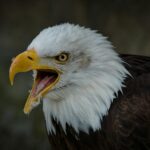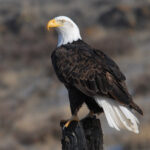Bald eagles are known to fly both alone and in groups, depending on the situation. When not breeding, bald eagles are gregarious and may form groups, especially during migration or when feeding on abundant food sources such as fish spawning grounds. However, they are also solitary hunters and will fiercely defend their territory during breeding season.
Bald Eagles and Their Flocking Behavior
Bald eagles are known to exhibit social behavior and can often be seen flying in groups, particularly during certain times of the year. Here’s a closer look at when and why bald eagles may fly in groups:
Migration and Feeding
During migration, bald eagles may form large flocks as they travel long distances to their wintering grounds or breeding sites. These groups can consist of dozens or even hundreds of birds, taking advantage of the updrafts and thermal currents to conserve energy during their journey.
Similarly, bald eagles may gather in groups when feeding on abundant food sources, such as fish spawning grounds or areas with a high concentration of carrion. By working together, the eagles can more effectively locate and capture prey, making the most of the available resources.
Breeding Season
While bald eagles are generally solitary during the breeding season, they may occasionally be seen flying in pairs or small groups. This is typically observed when the birds are engaged in courtship displays or when a pair is defending their territory against intruders.
Roosting
Bald eagles are also known to roost in groups, particularly during the winter months when they may congregate in areas with plentiful food sources. These roosting sites can provide the birds with protection from the elements and a sense of community.
Bald Eagles’ Hunting Strategies
 Image source: Bald Eagle (Haliaeetus leucocephalus) in Kachemak Bay, Alaska
Image source: Bald Eagle (Haliaeetus leucocephalus) in Kachemak Bay, Alaska
Bald eagles are skilled hunters and have developed various strategies to capture their prey, which consists primarily of fish, but also includes small mammals, waterfowl, and carrion.
Solitary Hunting
While bald eagles may form groups in certain situations, they are also known to be solitary hunters. When hunting alone, bald eagles use their excellent eyesight to spot prey from great heights, then dive down at high speeds to capture their target with their powerful talons.
Cooperative Hunting
In some cases, bald eagles have been observed engaging in cooperative hunting, where a group of birds work together to locate and capture prey. This can be particularly effective when targeting larger or more elusive prey, such as waterfowl or small mammals.
Bald Eagle Conservation Efforts
Bald eagle populations were once severely threatened due to habitat loss, pesticide exposure, and hunting. However, thanks to conservation efforts, their numbers have rebounded significantly in recent decades.
Habitat Protection
One of the key factors in the recovery of bald eagle populations has been the protection and restoration of their natural habitats, such as old-growth forests, coastal areas, and riverine ecosystems. This has provided the birds with the resources they need to thrive, including nesting sites and abundant food sources.
Legislation and Enforcement
The Bald and Golden Eagle Protection Act, enacted in 1963, has played a crucial role in the conservation of bald eagles. This law prohibits the hunting, killing, or possession of bald eagles, as well as the destruction of their nests and eggs. Strict enforcement of this legislation has helped to safeguard bald eagle populations.
Conclusion
Bald eagles are remarkable birds that exhibit a range of social and hunting behaviors, including the ability to fly in groups. While they are often solitary hunters, they may form flocks during migration, feeding, and roosting. The recovery of bald eagle populations is a testament to the success of conservation efforts, and it is crucial that we continue to protect these majestic birds and their habitats for generations to come.




